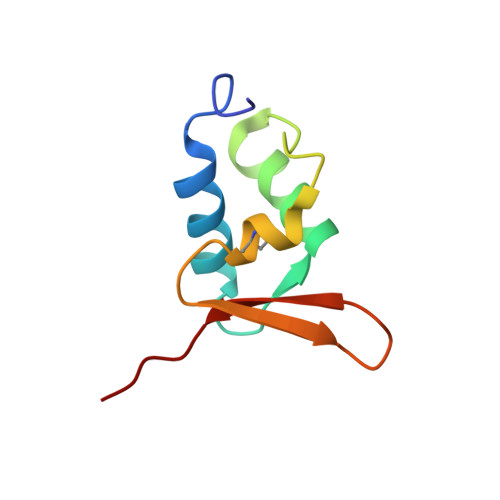Structure of Drosophila Oskar reveals a novel RNA binding protein
Yang, N., Yu, Z., Hu, M., Wang, M., Lehmann, R., Xu, R.M.(2015) Proc Natl Acad Sci U S A 112: 11541-11546
- PubMed: 26324911
- DOI: https://doi.org/10.1073/pnas.1515568112
- Primary Citation of Related Structures:
5CD7, 5CD8, 5CD9 - PubMed Abstract:
Oskar (Osk) protein plays critical roles during Drosophila germ cell development, yet its functions in germ-line formation and body patterning remain poorly understood. This situation contrasts sharply with the vast knowledge about the function and mechanism of osk mRNA localization. Osk is predicted to have an N-terminal LOTUS domain (Osk-N), which has been suggested to bind RNA, and a C-terminal hydrolase-like domain (Osk-C) of unknown function. Here, we report the crystal structures of Osk-N and Osk-C. Osk-N shows a homodimer of winged-helix-fold modules, but without detectable RNA-binding activity. Osk-C has a lipase-fold structure but lacks critical catalytic residues at the putative active site. Surprisingly, we found that Osk-C binds the 3'UTRs of osk and nanos mRNA in vitro. Mutational studies identified a region of Osk-C important for mRNA binding. These results suggest possible functions of Osk in the regulation of stability, regulation of translation, and localization of relevant mRNAs through direct interaction with their 3'UTRs, and provide structural insights into a novel protein-RNA interaction motif involving a hydrolase-related domain.
Organizational Affiliation:
National Laboratory of Biomacromolecules, Institute of Biophysics, Chinese Academy of Sciences, Beijing 100101, China; College of Life Sciences, University of Chinese Academy of Sciences, Beijing 100049, China; yangna@moon.ibp.ac.cn Ruth.Lehmann@med.nyu.edu rmxu@sun5.ibp.ac.cn.
















